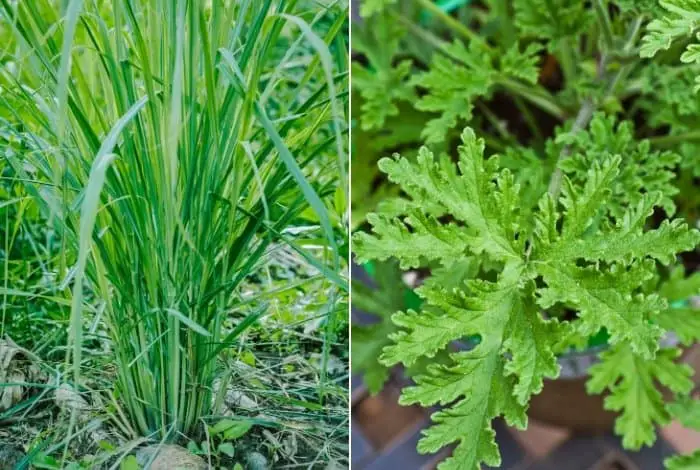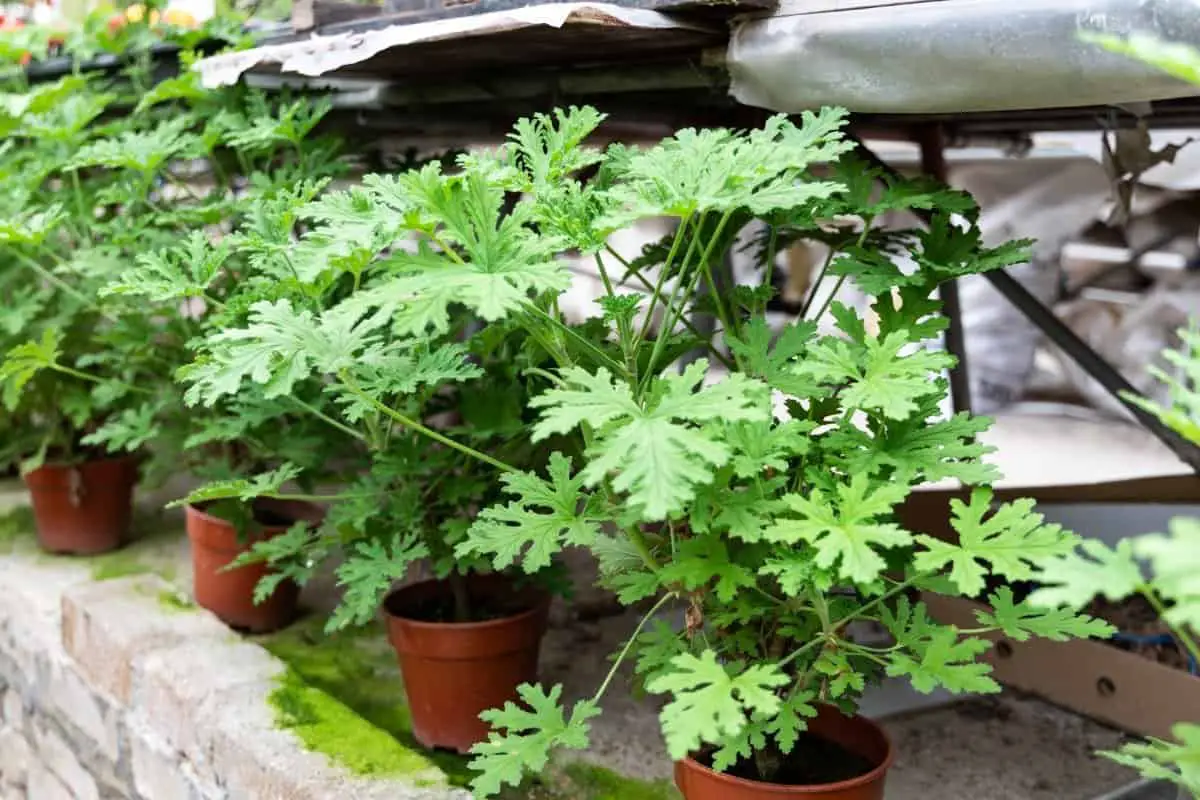Last Updated on February 2, 2022 by Cinthia
Are you wondering how to care for the citronella plant in order to effectively protect you and your loved ones from the troublesome mosquitoes? Maybe you are thinking of growing a few of them around your patio or indoors to keep the mosquitoes away.
Citronella plant is a scented geranium native to Asia and known as a mosquito repellent. This plant grows up to about 2 feet tall. It belongs to the pelargonium genus and has a distinctive fragrance. It is an attractive annual plant with small lavender flowers that do well both in the garden and as a potted plant.
This plant is available as a starter plant but not as seeds. Transplant your young citronella plant to a larger pot or into your garden. Use well-drained soil for potted plants. Or choose an area with good drainage which receives plenty of sun about 6 to 8 hours daily. Ensure good air circulation around the plant throughout the day.
Citronella Differences
Citronella is quite confusing to most people. This is because there are two types of plants considered as Citronella. The tropical grass known as Cymbopogon nardus is popular as the true Citronella. This is because it has an essential oil derived from it.

The scented geranium is more common and is effective in keeping mosquitoes away. For its maximum effectiveness, grow several plants in areas you want to deter insects. You may choose to grow the variety that entices you! They both have minimal requirements and are hassle-free.
Important Steps On How To Care For A Citronella Plant
Citronella plant care requires very minimal effort and low maintenance. The care includes:
- Plant your Citronella in the spring season in well-drained soil.
- Use organic manure to provide the required nutrients.
- Water your plant well after planting and keep the soil moist always but not soggy
- Remove any leaves that turn yellow which is a normal occurrence. Prune off any spent leaves to keep the plant looking attractive.
- Make sure your soil is alkaline or neutral.
- Use a fertilizer once per month to keep the leaves green.
- Use insecticidal soap or a combination of canola oil and soap to control insects. 1 tablespoon of oil added to 1 quart of soapy water is the correct proportion.
- Provide enough sunlight for this plant – about 6 hours every day.
- Do not grow it in damp areas or in the winter season; it will die due to frost. During winter move it indoors until the ground warms up in the spring.
- Weed the soil around the plants to remove all weeds that take valuable moisture and nutrients away from the plant.
- You can grow it alongside other plants like thyme, mint, coleus, and nasturtium. It is an excellent companion plant.
Clovers Garden 2 Large Citronella Mosquito Repellent Plants in 4-Inch Pots

Read more about The Best Way to Get Rid of Mosquitoes
Common Problems And How To Deal With Them
The most common problem is dark spots on the plant’s leaves. It is a sign that plants are receiving too much water. Remove any affected leaves and allow the soil to dry out before watering any more. When you resume watering, do not water the leaves of the plant. Water at the base of the plant only!
Pests also affect the Citronella plant. Whitefly, mealybugs, and caterpillars are the main pests that target this plant. Check your plant regularly for any signs of infestation. Apply neem oil or horticultural oil to the infected plants. You can do this from time to time to remove any stubborn infestations.
Uses Of Citronella Plant
Citronella plant has several uses which include:
- A very pretty plant to decorate your outdoor living space
- It is popular for use as a mosquito and other insects repellant. Cut a leaf and rub it on your skin to keep mosquitoes away from you. It can be used even on sensitive skin with no side effects. To make a liniment that you can rub or spray on your skin,
Fill a glass jar half full with citronella leaves, flowers and add some isopropyl alcohol
Cover and allow it to steep for 1 week.
Strain and apply it to your skin as required.
Conclusion
Citronella plants are worth growing! These plants are pretty sitting in your office desk, patio, or your garden. They are versatile and easy to take care of without much hassle. When well-trimmed, it features a plant with gorgeous lavender blooms.
Citronella plants are one of the most popular geraniums out there! Their ability to repel mosquitoes and other insects within the house is one important aspect of why it’s grown. These plants flourish almost anywhere; they look and smell amazing!
Keep watering, give them 6 hours of sunlight each day, do a little pruning, and voila you have a plant to enjoy its scent all day long.
FAQs
How do you care for a potted citronella plant?
Citronella plants are easy to care for but they do require plenty of light. The plant's roots are located just below the surface of the soil, so it is important to keep the soil moist but not wet. It can be difficult to know when a citronella plant needs water because its leaves are typically dry when it gets hot outside - this is why you should monitor your potted citronella plant's soil moisture level with a moisture meter or by using your finger to feel for moisture on top of the soil.
They need a considerable amount of fresh water, and they should be pruned every few weeks. If you have a potted citronella plant, you'll want to make sure that you can get the leaves wet during the summer months when it is hot out.
How often do you water citronella plants?
Citronella plants need a lot of water and care, so they must be watered very frequently. When you water them, make sure that the soil is moist and not wet. They need a well-drained soil that has been amended with compost or aged manure to grow properly.
The key to keeping your citronella plant thriving is to give it a good drink of water every other day. This shouldn't come as too big of a surprise when you consider that Citronella plants have a long history of being used for their mosquito repelling properties. They are most common in countries in the southern hemisphere, particularly Australia.
Why are citronella plants great for gardens?
Citronella is an extremely popular plant in the United States, but not many people know about its origins. It was originally brought to the country by settlers from Europe and is now common in gardens, backyards and parks.
Citronella plants will grow well with most any type of soil which makes them great plants for those who are just getting into gardening. They also grow in shady areas and can thrive even under partial shade, so if you have limited space to work with they are quite ideal.
Many people consider citronella as a great plant for adding a little bit of fragrance to their garden. The leaves can be burned as an insect repellant and are known to act as a natural mosquito repellant.
Do citronella plants need a lot of sun?
Citronella plants are known for their herbal scent and the use of citronella candles. They also make good garden plants for those who do not have enough sunlight.
Do citronella plants need a lot of sun? Yes, they need plenty of light because they are not able to produce their own. The sun is also needed for the plant’s pollination process as well as its vitality and growth.
Can you plant citronella outside?
Citronella plant is a perennial evergreen shrub or small tree that originated in the Mediterranean region. It has a light, fresh fragrance; does not get smelly like many other plants do.
You can plant the citronella bush outside if you live where it will not be damaged by cold weather. However, make sure that you place it in an area where it will get good sunlight and isn't too close to your home or garden, as the plant can spread quickly and take over an area.
Caroline is a gardener who loves to get down to the nitty–gritty of gardening. She proudly proclaims herself as a ‘dirt worshipper‘ and can often be found deep in the garden, covered in soil and singing to her plants. As a self–proclaimed ‘plant whisperer‘, Caroline believes that plants need love and attention just like any other living thing, and she loves to give them both. When she‘s not tending to her garden, you can often find her researching the latest gardening trends, or teaching others how to make their gardens thrive


